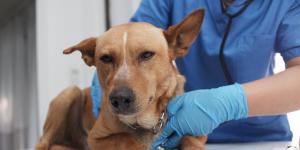Canine Distemper Treatment at Home



See files for Dogs
Canine distemper virus (CDV), also known as footpad disease, is a viral disease that can affect a variety of mammals and is one of the most serious diseases dogs can contract. It is characterized by symptoms such as nasal discharge, nervous tics and conjunctivitis. It is also an extremely contagious disease, so if you have several pets at home, precautions should be taken and a veterinarian should be consulted at the first sign of suspicion. Canine distemper is not curable. Treatment usually includes supportive care and measures to prevent secondary infections, control vomiting, diarrhea and neurologic signs, and combat dehydration by administering fluids.
In this AnimalWised article, we will explain some of the most effective home remedies for treating canine distemper. However, keep in mind that they are by no means a substitute for the treatment prescribed by your veterinarian, but rather a complementary measure to alleviate your dog's distemper symptoms.
- What is the canine distemper virus?
- Home remedies to treat canine distemper
- How to treat fever in a dog with distemper at home
- How to get a dog with distemper to eat
- How to treat cough in a dog with distemper at home
- How to treat vomiting in a dog with distemper at home
- How to treat diarrhea in a dog with distemper at home
- How to treat tremors in a dog with distemper at home
- How to treat seizures in a dog with distemper at home
- How to treat crying and whining in a dog with distemper at home
- How to treat labored breathing in a dog with distemper at home
- How to treat eye secretions in a dog with distemper at home
- Can humans contract canine distemper?
What is the canine distemper virus?
We will first cover a general overview of home remedies for distemper in dogs, in order to eliminate the most common doubts about this disease. However, you can find more information in our complete guide to canine distemper, which includes the various causes, symptoms, and treatment.
What is distemper in dogs?
Canine distemper virus, which belongs to the family Paramyxoviridae (the same family of viruses that cause measles, mumps, and bronchiolitis in humans). It is an infectious-contagious disease of viral origin. It can be transmitted to all types of dogs, but primarily affects unvaccinated puppies, as well as older dogs. Likewise, it also infects various tissues of the animal. The virus is particularly contagious and survives for weeks in the environment.
In dogs, CDV affects multiple body systems, including the gastrointestinal and respiratory tracts, as well as the spinal cord and brain. Common symptoms include high fever, eye/nose discharge, labored breathing and coughing, vomiting and diarrhea, loss of appetite and lethargy. In the following sections, we will discuss various home remedies for each of the symptoms of the disease.
Is distemper in dogs curable?
CDV is not currently curable, so treatment is mainly symptomatic and supportive. Be suspicious of sources that claim to be able to cure canine distemper with home remedies or medications. Treatment should be aimed at treating the fluid/electrolyte imbalance and neurologic symptoms, and preventing secondary bacterial infections.
CDV has a wide range of mortality rates, ranging from 50 to 95% of cases, depending on the immune status of the infected dogs. The highest mortality rates occur in puppies, which are at higher risk for complications such as pneumonia and encephalitis. Older dogs that contract distemper may develop encephalomyelitis and vestibularis.
Appearance of distemper in vaccinated dogs
Vaccinations provide between 2 and 3 years of immunity to the dog. However, if the vaccinations are not maintained, the dog may lose immunity. Immune suppression may occur in dogs with other health problems and even anxiety and stress.
How long does distemper last?
It is impossible to predict the time it will take for your dog to recover from distemper. Once again, this will depend on when you begin veterinary treatment, on the strain of virus, and on your dog's immunity.

Home remedies to treat canine distemper
Next, we will talk about some home remedies for canine distemper. It is important to remember that these remedies can in no way replace veterinary treatment. The main aim of these home remedies is to relieve the painful symptoms of canine distemper, not to cure it. Moreover, their use should always be agreed with the specialist who treats our case.
Here are the most common symptoms of canine distemper and the home remedies you can use to alleviate those symptoms:
How to treat fever in a dog with distemper at home
Dogs with fever are easily dehydrated, so it is extremely important to encourage the dog to drink. If your dog refuses to drink water, talk to your veterinarian about the possibility of giving water to your dog with a syringe. Fluid therapy is also possible if the dog is housed in a veterinary clinic.
A cool compress can also be helpful in bringing down the fever. Wet a cloth, wring it out and gently rub the animal's belly with it. Alternatively, you can wrap the animal in a cold towel. However, it is advisable to do this only in summer to prevent a dramatic drop in the dog's body temperature.

How to get a dog with distemper to eat
Canine distemper is commonly associated with loss of appetite, but we must make sure the dog eats, because their recovery depends on it. In these cases, it is highly recommended to buy moist intestinal food, since it is more digestible.
You can cook it with warm water or broth (without onions or salt). Ideally, you should not limit your dog to one type of food, but vary it a lot to keep the dog interested. We can add chopped chicken or liver or change the type of wet food. The addition of other foods should always be discussed with your veterinarian.
You can know about other tricks and tips to encourage your dog to eat by reading this article on my dog isn't eating.
How to treat cough in a dog with distemper at home
Persistent cough is often a serious symptom in dogs with distemper. First, you should clean your home with enzymatic products to remove traces of dust, dirt or organic material. Also, you should avoid smoking in the presence of your dog. If possible, you can also increase the humidity with a humidifier. If you do not have one, you can take the dog into the bathroom with you while you shower.
If your dog can walk but pulls anxiously, you should replace the collar with a harness to avoid irritation of the trachea and larynx. Finally, we should also encourage calm behavior, as stress and anxiety contribute to coughing. A veterinarian can also prescribe antitussives, which are commonly known as cough suppressants, in more severe cases.
If you notice that your dog is very stressed or anxious, then you should read the following article on how to calm a dog down.

How to treat vomiting in a dog with distemper at home
Another common symptom that dogs with distemper exhibit is vomiting. In many cases, this disease causes a gastrointestinal infection that damages the dog's stomach. After vomiting, food intake should be restricted for a few hours.
Afterward, you should start giving small amounts of food every four hours, preferably a wet gastrointestinal food or a soft dog food, including two parts of cooked rice with one part of cooked chicken without skin. As we mentioned previously, you should not add salt, but you can add olive oil.
As a result of vomiting, the dog may stop drinking water, therefore increasing the risk of dehydration. In these cases, we will not force the dog to drink, but we can wet the muzzle lightly with water to stimulate the dog to drink.
How to treat diarrhea in a dog with distemper at home
Another consequence of gastrointestinal infections due to distemper is diarrhea with or without blood. As in the previous case, it is advisable to limit food intake for a few hours and to opt for a soft diet or gastrointestinal wet food.
You should provide your dog with food in small amounts every four hours. You should also try to keep your dog hydrated by encouraging them to drink or moistening their noses lightly. Furthermore, you should try to provide calmness and serenity in their environment.
You can learn more about what food and diet to give your dog when they have diarrhea by reading this other article about home remedies for diarrhea in dogs.

How to treat tremors in a dog with distemper at home
Tremors are very common in dogs with canine distemper. They usually affect the extremities, usually in the posterior region, but may also affect the skull and be accompanied by chewing movements. Dogs with distemper may also show symptoms when they are sleeping. If they are extremely ill, they may also be unable to walk. If this is the case, you must never force a dog to move if it does not want to. The dog should be allowed to rest in a soft, comfortable place.
How to treat seizures in a dog with distemper at home
A dog with neurologic distemper will most likely have seizures. The veterinarian will prescribe the appropriate medications, such as antibiotics and phenobarbital, intravenously, orally, or intramuscularly. We must carefully follow the instructions of the specialist. Additionally, the dog should get plenty of rest while they recover. Avoid upsetting them and keep them as relaxed as possible.

How to treat crying and whining in a dog with distemper at home
This disease causes the dog's body to show unpleasant symptoms, which is why they often seem sad and depressed, crying and even whining. We must be especially patient and loving and make the dog feel safe, accompanied and loved during this illness. We must not yell at or punish our dog under any circumstances. Furthermore, we must also keep in mind that by trying to improve his well-being, we can ensure a better prognosis.
Make sure your dog's sleeping area is as comfortable as possible, make food as digestible and palatable as possible, and spend time every day petting and playing with your dog. In summary, try to make your dog's daily routine as comfortable and predictable as possible, do not force them to do anything they do not want to do, and simplify their routine. You can bring them bowls of water and food or wash them, so they do not have to do it himself.
In case you suspect that your dog is feeling sad, you may wish to read this other article about this, my dog seems sad.
How to treat labored breathing in a dog with distemper at home
You can start by cleaning the nasal discharge, which is usually green and purulent, with a gauze swab moistened with warm water.
On the other hand, warm food will clear the sinuses of congestion. You can include a bowl of broth without salt and without onions in their diet to help your dog's respiratory system. Always remember to check the temperature before offering it to your dog to avoid a possible burn.
You can also increase the humidity in the environment with a humidifier or take our dog to the bathroom when we shower.
You can also use a sterile saline solution from the pharmacy to clear the sinuses and reduce irritation. It is enough to put one or two drops in each hole.

How to treat eye secretions in a dog with distemper at home
Eye secretions are very common in dogs suffering from distemper. These will probably decrease if you give your dog antibiotics, which must always be prescribed by a veterinarian. Nevertheless, it is important to remove them with a sterile gauze moistened in warm water previously boiled or with chamomile, which should not contain vegetable residues. Additionally, you can also use an optic solution available at the pharmacy.
Cleaning a dog's eyes can be difficult and must be done carefully. If you want to know more about how to do it, do not miss this other article about how to clean a dog's eyes.
Can humans contract canine distemper?
It is perfectly normal for caregivers of distemper-suffering dogs to wonder if canine distemper is contagious to humans. However, we must know that this disease is not a zoonosis, but an exclusive disease of canids and other animal species that is not contagious to humans. Although canine distemper virus can survive in the human body, it has not developed the ability to infect and replicate human cells. However, if you come into contact with a dog with canine distemper, you can become a carrier of the disease even if you do not show symptoms.
If you want to learn more about what diseases a dog can transmit to a person, read this article on 9 diseases dogs can transmit to humans.

This article is purely informative. AnimalWised does not have the authority to prescribe any veterinary treatment or create a diagnosis. We invite you to take your pet to the veterinarian if they are suffering from any condition or pain.
If you want to read similar articles to Canine Distemper Treatment at Home, we recommend you visit our Viral diseases category.
- The Doctors Book of Home Remedies for Dogs and Cats, Rodale Press, 1996
- Kate E. Creevy, DVM, MS, DACVIM, Canine Distemper (Hardpad Disease), Merck Manual
- Kate E. Creevy, DVM, MS, DACVIM, Canine Distemper Overview, Merck Manual
- Greene, Craig E. Infectious Diseases of the Dog and Cat-E-Book. Elsevier Health Sciences, 2013.
- Martella, Vito, Gabrielle Elia, and Canio Buonavoglia. "Canine distemper virus." Veterinary Clinics of North America: Small Animal Practice 38.4 (2008): 787-797.
- Beineke, A., et al. "Pathogenesis and immunopathology of systemic and nervous canine distemper." Veterinary immunology and immunopathology 127.1-2 (2009): 1-18.
- Blixenkrone-Møller, Merete, et al. "Studies on manifestations of canine distemper virus infection in an urban dog population." Veterinary microbiology 37.1-2 (1993): 163-173.
- Martella, Vito, Gabrielle Elia, and Canio Buonavoglia. "Canine distemper virus." Veterinary Clinics of North America: Small Animal Practice 38.4 (2008): 787-797.
- Chappuis, G. "Control of canine distemper." Veterinary microbiology 44.2-4 (1995): 351-358.
- Hoerlein, Benjamin Franklin. "Canine neurology: diagnosis and treatment." Canine neurology: diagnosis and treatment. (1965).
- Ek-Kommonen, C., et al. "Outbreak of canine distemper in vaccinated dogs in Finland." Veterinary Record 141 (1997): 380-382.












